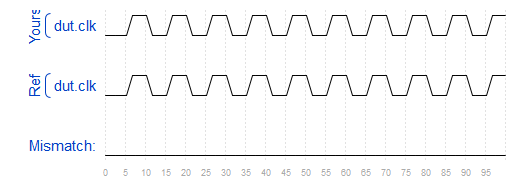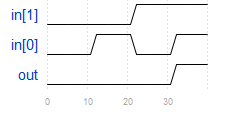HDLBits 系列(40)如何写 TestBench 文件?
序言
由于入门的测试文件很简单,所以一直以来也都是直接给出测试文件,直到今天才想着去总结一个测试文件的写法。这篇博客将根据HDLBits的题目来总结如何书写Testbench文件,肯定有不完善的地方,仅仅作为一次总结吧。
TestBench文件,又称为TB文件,是用来对设计文件进行测试的程序,它与设计文件不同的地方在于,它使用的语法可以是不可综合的,比较灵活,不仅仅可以使用Verilog来写Tb文件,还可以使用其他语言,例如sv等。
写好一个基本的测试文件比较简单,但是写好一个比较完善的测试文件还是比较具有挑战性的。
Tb文件包括那些组件呢?
- 变量定义;
- 时钟生成;
- 待测试模块输入设计;
- 例化待设计模块。
那我们就开始吧。
变量定义
这个比较简单,所谓的变量定义,就是将待测试设计的输入在Tb文件中进行定义,方便后面对其数值进行设计。
待测试模块的输入定义为reg类型,因为我们要对其进行设计,输出定义为wire类型,它作为例化模块的输出,所以必须定义为wire类型。
例如,我们要测试一个D触发器:
module dff(
input clk,
input d,
input areset,
output q;
);
reg q_mid;
always@(posedge clk or posedge areset ) begin
if(areset) q_mid <= 0;
else q_mid <= d;
end
assign q = q_mid;
endmodule
- 1
- 2
- 3
- 4
- 5
- 6
- 7
- 8
- 9
- 10
- 11
- 12
- 13
我们在写测试文件的时候,对其输入输出进行定义,如下:
module test_dff();
// input define
reg clk;
reg d;
reg areset;
// output define
wire q;
//other parts
//......
endmodule
- 1
- 2
- 3
- 4
- 5
- 6
- 7
- 8
- 9
- 10
- 11
好了,这部分讲完了,进入下一部分,时钟生成。
时钟设计
对于时钟的设计,我们有两种写法,都是通过循环的方式来实现。
- forever
- always
第一种方式,也是我比较喜欢的方式,使用forever进行时钟的设计:
还是以上一个例子为例,待测试模块为dff:
module test_dff();
// input define
reg clk;
reg d;
reg areset;
// output define
wire q;
localparam PERIOD = 4;
// clk generate
initial begin
clk = 0;
forever # (PERIOD/2) clk = ~clk;
end
//other parts
//......
endmodule
- 1
- 2
- 3
- 4
- 5
- 6
- 7
- 8
- 9
- 10
- 11
- 12
- 13
- 14
- 15
- 16
- 17
- 18
可以看到,时钟生成部分很容易,需要注意的是必须在initial的内容进行输入的设计(时钟也属于输入),可以这么说,测试文件的reg(输入)几乎都是在initial内部完成的,这是一种有时间顺序的系列行为。
另一种方式是使用always的方式来设计时钟,如下:
module test_dff();
// input define
reg clk;
reg d;
reg areset;
// output define
wire q;
localparam PERIOD = 4;
// clk generate
initial begin
clk = 0;
end
always begin
#(PERIOD/2) clk = ~clk;
end
//other parts
//......
endmodule
- 1
- 2
- 3
- 4
- 5
- 6
- 7
- 8
- 9
- 10
- 11
- 12
- 13
- 14
- 15
- 16
- 17
- 18
- 19
- 20
可以看出区别,这种方式是在initial里面首先将clk初始化为0,之后在initial外部进行clk循环反转设计。
这是规则,需要严格遵守。
介绍完这两种方式之后,我们来看看HDLBits中对应这一部分的例题:
Tb/clock
原题复现:
You are provided a module with the following declaration:
module dut ( input clk ) ;
Write a testbench that creates one instance of module dut (with any instance name), and create a clock signal to drive the module’s clk input. The clock has a period of 10 ps. The clock should be initialized to zero with its first transition being 0 to 1.

好吧,给出我的设计:
module top_module ( ); reg clk; initial begin clk = 0; forever #5 clk = ~clk; end dut inst_dut( .clk(clk) );
endmodule
- 1
- 2
- 3
- 4
- 5
- 6
- 7
- 8
- 9
- 10
- 11
- 12
- 13

设计输入
其实时钟也是输入,输入的设计和时钟的设计方式没有什么差别,只不过更加的多样化,我们可以使用task,function等等,当然也可以直接设计。
这里就不那么多废话了,突然感觉前面说了很多多余的东西,这里就怎么简单怎么来吧。
看这个例子:
input design
原题复现:
Create a Verilog testbench that will produce the following waveform for outputs A and B:

我的设计:
module top_module ( output reg A, output reg B );// // generate input patterns here initial begin A = 0; B = 0; #10 A = 1; #5 B = 1; #5 A = 0; #20 B = 0; end
endmodule
- 1
- 2
- 3
- 4
- 5
- 6
- 7
- 8
- 9
- 10
- 11
- 12
- 13
- 14
- 15
- 16
- 17
- 18
- 19
当然,在实际写tb文件时候,肯定不是这样的整体格式,这里是为了适应做相应的题目需要。
实际中的格式是:
module top_module ( );// // generate input patterns here initial begin A = 0; B = 0; #10 A = 1; #5 B = 1; #5 A = 0; #20 B = 0; end
endmodule
- 1
- 2
- 3
- 4
- 5
- 6
- 7
- 8
- 9
- 10
- 11
- 12
- 13
- 14
- 15
- 16
- 17
- 18
- 19
模块例化
模块例化是测试文件中必须的,因为我们写测试文件的目的就是测试待测试模块。
举个例子,我们下面来测试一个与门:
题目链接
You are given the following AND gate you wish to test:
module andgate ( input [1:0] in, output out
);
- 1
- 2
- 3
- 4
Write a testbench that instantiates this AND gate and tests all 4 input combinations, by generating the following timing diagram:

我的设计:
module top_module(); reg [1:0] in; wire out; initial begin in = 2'b00; #10 in = 2'b01; #10 in = 2'b10; #10 in = 2'b11; end andgate inst( .in(in), .out(out) );
endmodule
- 1
- 2
- 3
- 4
- 5
- 6
- 7
- 8
- 9
- 10
- 11
- 12
- 13
- 14
- 15
- 16
- 17
- 18
- 19
- 20
- 21
实战演练
题目链接
The waveform below sets clk, in, and s:

Module q7 has the following declaration:
module q7 ( input clk, input in, input [2:0] s, output out
);
- 1
- 2
- 3
- 4
- 5
- 6
Write a testbench that instantiates module q7 and generates these input signals exactly as shown in the waveform above.
我的设计:
module top_module(); reg clk; reg in; reg [2:0] s; wire out; initial begin clk = 0; forever begin #5 clk = ~clk; end end initial begin in = 0; s = 2; #10 s = 6; #10 in = 1; s = 2; #10 in = 0; s = 7; #10 in = 1; s = 0; #30 in = 0; end q7 inst( .clk(clk), .in(in), .s(s), .out(out) ); endmodule
- 1
- 2
- 3
- 4
- 5
- 6
- 7
- 8
- 9
- 10
- 11
- 12
- 13
- 14
- 15
- 16
- 17
- 18
- 19
- 20
- 21
- 22
- 23
- 24
- 25
- 26
- 27
- 28
- 29
- 30
- 31
- 32
- 33
- 34
- 35
- 36
- 37
- 38
- 39
- 40
- 41
- 42
- 43
- 44
- 45
在加上一个题目:
Tff testbench
You are given a T flip-flop module with the following declaration:
module tff ( input clk, input reset, // active-high synchronous reset input t, // toggle output q
);
- 1
- 2
- 3
- 4
- 5
- 6
Write a testbench that instantiates one tff and will reset the T flip-flop then toggle it to the “1” state.
我的设计为:
module top_module (); reg clk; reg reset; reg t; wire q; initial begin clk = 0; forever #2 clk = ~clk; end initial begin reset = 1; t = 0; #4 reset = 0; t = 1; end tff inst( .clk(clk), .reset(reset), .t(t), .q(q) ); endmodule
- 1
- 2
- 3
- 4
- 5
- 6
- 7
- 8
- 9
- 10
- 11
- 12
- 13
- 14
- 15
- 16
- 17
- 18
- 19
- 20
- 21
- 22
- 23
- 24
- 25
- 26
- 27
- 28
- 29
- 30
- 31
- 32
这篇博文就到这里吧,这是最基础,最简单的测试文件的写法,当然,基础很重要,在此基础上,才能够在上一层楼。
文章来源: reborn.blog.csdn.net,作者:李锐博恩,版权归原作者所有,如需转载,请联系作者。
原文链接:reborn.blog.csdn.net/article/details/103530724
- 点赞
- 收藏
- 关注作者


评论(0)